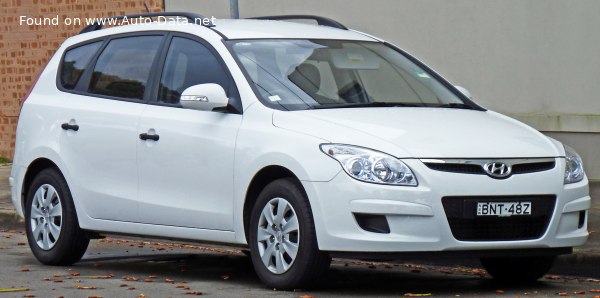









| What is the body type, Hyundai i30 I CW? | Station wagon (estate), 5 Doors, 5 Seats |
|---|---|
| What is the fuel economy, Hyundai i30 I CW 2.0 (143 Hp) Automatic? | 7.6 l/100 km 30.95 US mpg 37.17 UK mpg 13.16 km/l |
| How ECO is the car, Hyundai i30 2.0 (143 Hp) Automatic? | Euro 4 |
| How fast is the car, 2008 i30 I CW 2.0 (143 Hp) Automatic? | 195 km/h | 121.17 mph 0-100 km/h: 11.1 sec 0-60 mph: 10.5 sec |
| How much power, Hyundai i30 Station wagon (estate) 2008 2.0 (143 Hp) Automatic? | 143 Hp, 186 Nm 137.19 lb.-ft. |
| What is the engine size, Hyundai i30 Station wagon (estate) 2008 2.0 (143 Hp) Automatic? | 2.0 l 1975 cm3 120.52 cu. in. |
| How many cylinders, 2008 Hyundai 2.0 (143 Hp) Automatic? | 4, Inline |
| What is the drivetrain, Hyundai i30 I CW Station wagon (estate) 2008 2.0 (143 Hp) Automatic? | Front wheel drive. Internal Combustion engine. The Internal combustion engine (ICE) drives the front wheels of the vehicle. |
| How long is this vehicle, 2008 Hyundai i30 Station wagon (estate)? | 4475 mm 176.18 in. |
| How wide is the vehicle, 2008 Hyundai i30 Station wagon (estate)? | 1775 mm 69.88 in. |
| What is the curb weight, 2008 Hyundai i30 I CW 2.0 (143 Hp) Automatic? | 1310 kg 2888.06 lbs. |
| What is the gross weight, 2008 Hyundai i30 I CW 2.0 (143 Hp) Automatic? | 1900 kg 4188.78 lbs. |
| How much trunk (boot) space, 2008 Hyundai i30 Station wagon (estate)? | 415 - 1395 l 14.66 - 49.26 cu. ft. |
| How many gears, What type is the gearbox, 2008 Hyundai i30 I CW 2.0 (143 Hp) Automatic? | 4, automatic transmission |
| General information | |
|---|---|
| Brand | Hyundai |
| Model | i30 |
| Generation | i30 I CW |
| Modification (Engine) | 2.0 (143 Hp) Automatic |
| Start of production | 2008 year |
| End of production | 2010 year |
| Powertrain Architecture | Internal Combustion engine |
| Body type | Station wagon (estate) |
| Seats | 5 |
| Doors | 5 |
| Performance specs | |
| Fuel consumption (economy) - urban | 10.3 l/100 km
22.84 US mpg 27.43 UK mpg 9.71 km/l |
| Fuel consumption (economy) - extra urban | 6.1 l/100 km
38.56 US mpg 46.31 UK mpg 16.39 km/l |
| Fuel consumption (economy) - combined | 7.6 l/100 km
30.95 US mpg 37.17 UK mpg 13.16 km/l |
| Fuel Type | Petrol (Gasoline) |
| Acceleration 0 - 100 km/h | 11.1 sec |
| Acceleration 0 - 62 mph | 11.1 sec |
| Acceleration 0 - 60 mph (Calculated by Auto-Data.net) | 10.5 sec |
| Maximum speed | 195 km/h 121.17 mph |
| Emission standard | Euro 4 |
| Weight-to-power ratio | 9.2 kg/Hp, 109.2 Hp/tonne |
| Weight-to-torque ratio | 7 kg/Nm, 142 Nm/tonne |
| Engine specs | |
| Power | 143 Hp @ 6000 rpm. |
| Power per litre | 72.4 Hp/l |
| Torque | 186 Nm @ 4600 rpm. 137.19 lb.-ft. @ 4600 rpm. |
| Engine layout | Front, Transverse |
| Engine Model/Code | G4GC |
| Engine displacement | 1975 cm3 120.52 cu. in. |
| Number of cylinders | 4 |
| Engine configuration | Inline |
| Cylinder Bore | 82 mm 3.23 in. |
| Piston Stroke | 93.5 mm 3.68 in. |
| Compression ratio | 10.1:1 |
| Number of valves per cylinder | 4 |
| Fuel injection system | Multi-port manifold injection |
| Engine aspiration | Naturally aspirated engine |
| Valvetrain | DOHC |
| Engine oil capacity | 4 l 4.23 US qt | 3.52 UK qt |
| Engine oil specification |  Log in to see. Log in to see. |
| Coolant | 6.6 l 6.97 US qt | 5.81 UK qt |
| Space, Volume and weights | |
| Kerb Weight | 1310 kg 2888.06 lbs. |
| Max. weight | 1900 kg 4188.78 lbs. |
| Max load | 590 kg 1300.73 lbs. |
| Trunk (boot) space - minimum | 415 l 14.66 cu. ft. |
| Trunk (boot) space - maximum | 1395 l 49.26 cu. ft. |
| Fuel tank capacity | 53 l 14 US gal | 11.66 UK gal |
| Dimensions | |
| Length | 4475 mm 176.18 in. |
| Width | 1775 mm 69.88 in. |
| Height | 1565 mm 61.61 in. |
| Wheelbase | 2700 mm 106.3 in. |
| Front track | 1538 mm 60.55 in. |
| Rear (Back) track | 1536 mm 60.47 in. |
| Drag coefficient (Cd) | 0.31 |
| Minimum turning circle (turning diameter) | 10.4 m 34.12 ft. |
| Drivetrain, brakes and suspension specs | |
| Drivetrain Architecture | The Internal combustion engine (ICE) drives the front wheels of the vehicle. |
| Drive wheel | Front wheel drive |
| Number of gears and type of gearbox | 4 gears, automatic transmission |
| Front suspension | Independent, type McPherson with coil spring and anti-roll bar |
| Rear suspension | Independent multi-link spring suspension with stabilizer |
| Front brakes | Ventilated discs |
| Rear brakes | Disc |
| Assisting systems | ABS (Anti-lock braking system) |
| Steering type | Steering rack and pinion |
| Tires size | 205/55 R16 H |
| Wheel rims size | 16 |